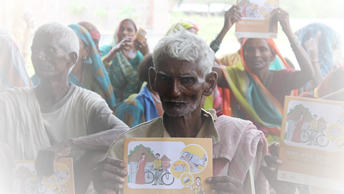What?
HOW CAN WE HELP YOU?
What financial inclusion obstacle are we supporting low-income people to navigate? What financial capability are we attempting to enable or develop? What – gives you access to MFO’s select publications organized around the content of a financial education curriculum or training manual. You can also gain access to the full set of Global Financial Education Program materials here.
Not finding what you are looking for? Click here.
Brand-Facing and Non-Brand Facing Factory Comparisons
In last week’s Garment Worker Diaries blog we promised further analysis of the types of factories in our study sample in Bangladesh. This week, we share that analysis with you by comparing brand-facing and non-brand facing factories.
The catalyst for performing this analysis was to see whether workers at two different types of factories in our study were faring as well as each other in terms of work hours, wages, health, and other metrics. We’ve defined elsewhere what brand-facing means, and we define it again for you in the blog.
What we discovered is that there are some statistically significant differences between what workers at each type of factory are telling us. We can’t yet be certain if the key difference is whether or not brands have a public, transparent relationship with one type of factory over another. But, that could certainly play a part.
We hope you’ll check out the full blog, and if you have any questions for us or the workers, please write to questions@workerdiaries.org
Warning: count(): Parameter must be an array or an object that implements Countable in /home/microf13/public_html/wp-content/themes/mfo/modules/looking_for_something_query.php on line 51

Garment Worker Diaries January 2021 Update
This week’s Garment Worker Diaries blog updates the project through the end of January 2021. In January, garment workers in Bangladesh worked more hours and made more money than in any other month since the COVID-19 pandemic began. And, these numbers largely track with the numbers we were seeing during this same time in 2019 and into 2020.
We realize this could imply that everything is going great for garment workers…we aren’t implying that. What we are saying is that the workers in our representative sample are as employed and earning as much money as they normally would. No one disputes that “as usual” is very far from ideal on a number of metrics (work hours, pay, illness, food insecurity, educational spending for children, and housing to name a few things we track).
Next week we are going to do our due diligence and zoom in on the factories in our study sample to see if there is any distinction in employment resiliency between those factories that are brand-facing and those that aren’t (we define brand-facing in this week’s blog). This will hopefully inform the current discussion about whether it is just “Tier 1” factories (think: larger with more money) that are managing to stay afloat compared to “Tier 2” and “Tier 3” factories (think: smaller with less money). It could be the case that workers in Tier 2 and 3 factories are not experiencing life as usual, and if that’s the case we need to find out.
We also hope you’ll check out our most recent #OpenDiaries post on Instagram. We asked garment workers what job benefits they wish they could demand, and how many of them have health insurance. And remember, you can always submit your own questions you’d like us to ask the workers. Just send an email to questions@workerdiaries.org to reach the workers.
Warning: count(): Parameter must be an array or an object that implements Countable in /home/microf13/public_html/wp-content/themes/mfo/modules/looking_for_something_query.php on line 51

Educational Aspirations Part Two: Garment Workers’ Educations
Last week in our Garment Worker Diaries blog series we discussed how far parents working in the RMG sector would like to see their children’s education progress, and what types of barriers their children might face climbing the education ladder.
In Part 2 of our Educational Aspirations blog this week, we discuss the workers’ educational ambitions for themselves. Many garment workers (20%) would still like to continue their education all the way on to university, despite the fact that 82% of them don’t have a secondary school certificate. The possible barriers they think they might face on this journey are somewhat different to the perceived barriers their children might face, but the need for additional income and the cost of school still appear to be two of the bigger roadblocks.
We also hope you’ll check out our most recent #OpenDiaries post on Instagram. We asked garment workers what job benefits they wish they could demand, and how many of them have health insurance. And remember, you can always submit your own questions you’d like us to ask the workers. Just send an email to questions@workerdiaries.org to reach the workers.
Warning: count(): Parameter must be an array or an object that implements Countable in /home/microf13/public_html/wp-content/themes/mfo/modules/looking_for_something_query.php on line 51

Educational Aspirations: Children of Garment Workers
In this week’s Garment Worker Diaries blog, we cover a subject our blog series hasn’t fully touched on yet: education.
We had so much to ask garment workers about the subject, and they had so much to tell us, that we’re splitting the blog up into two parts. Part #1 this week focuses on garment workers’ educational aspirations for their own children. Part #2 next week will focus on workers’ own hopes for themselves. We hope you’ll click through!
We’re also inviting you to join us next Thursday February 18th at 10am EST for Ethical New York Fashion Week. MFO’s project manager Dani Ortega will be speaking on a panel alongside Laudes Foundation and SANEM colleagues to discuss the true Supply Chain Heroes, who we all know are the workers. Tune in all week, and RSVP for our panel here: https://www.eventbrite.com/e/ethical-nyfw-supply-chain-heroes-tickets-138431559521
If there is anything in the blog that we did not cover and which you’d like to know about, please write us your thoughts at questions@workerdiaries.org. We can also pose questions directly to the workers themselves if there is anything specific you’d like more information about.
Warning: count(): Parameter must be an array or an object that implements Countable in /home/microf13/public_html/wp-content/themes/mfo/modules/looking_for_something_query.php on line 51

Return to Garment Workers’ Households
In this week’s Garment Worker Diaries blog, we put the spotlight back on the other salary-earning members of workers’ households. We haven’t given you an update on this since last summer, but every month since then we’ve been asking garment workers questions about the other people with whom they share their homes.
What we found according to the most recent data from December is that not much has changed since July. Similar proportions of garment workers are either sole salary earners or living with one or more additional salary earners. Work hours and salaries have held very stable over time, as have the variety of jobs and the workers performing those jobs.
Stability might not be the most provocative story, but as we think about what has to happen next, these data give us a good sense of the current situation.
If there is anything in the blog that we did not cover and which you’d like to know about, please write us your thoughts at questions@workerdiaries.org. We can also pose questions directly to the workers themselves if there is anything specific you’d like more information about.
Warning: count(): Parameter must be an array or an object that implements Countable in /home/microf13/public_html/wp-content/themes/mfo/modules/looking_for_something_query.php on line 51







